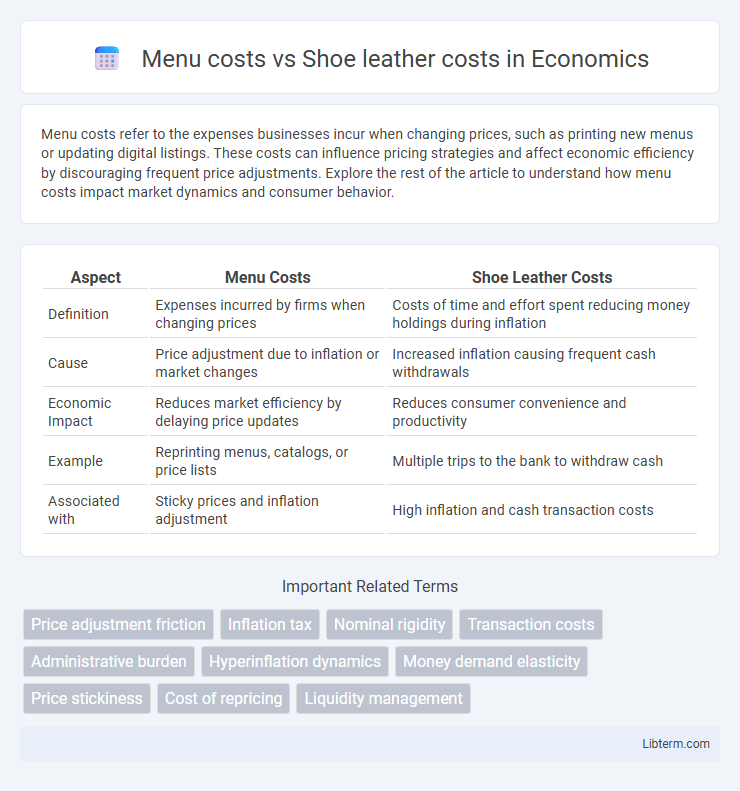Menu costs refer to the expenses businesses incur when changing prices, such as printing new menus or updating digital listings. These costs can influence pricing strategies and affect economic efficiency by discouraging frequent price adjustments. Explore the rest of the article to understand how menu costs impact market dynamics and consumer behavior.
Table of Comparison
| Aspect | Menu Costs | Shoe Leather Costs |
|---|---|---|
| Definition | Expenses incurred by firms when changing prices | Costs of time and effort spent reducing money holdings during inflation |
| Cause | Price adjustment due to inflation or market changes | Increased inflation causing frequent cash withdrawals |
| Economic Impact | Reduces market efficiency by delaying price updates | Reduces consumer convenience and productivity |
| Example | Reprinting menus, catalogs, or price lists | Multiple trips to the bank to withdraw cash |
| Associated with | Sticky prices and inflation adjustment | High inflation and cash transaction costs |
Introduction to Menu Costs and Shoe Leather Costs
Menu costs refer to the expenses businesses incur when changing prices, such as printing new menus or updating price tags, often significant during periods of high inflation. Shoe leather costs represent the increased effort and inconvenience consumers face as they minimize cash holdings and make more frequent trips to the bank to avoid holding depreciating money. Both concepts highlight different economic inefficiencies caused by inflation, with menu costs affecting firms' pricing strategies and shoe leather costs influencing consumer behavior.
Defining Menu Costs
Menu costs refer to the expenses businesses incur when changing prices, including printing new menus, updating marketing materials, and adjusting electronic pricing systems. These costs can lead firms to avoid frequent price changes, contributing to price stickiness in the economy. In contrast, shoe leather costs arise from the increased effort consumers make to minimize money holdings during inflation, reflecting a different type of economic friction.
Understanding Shoe Leather Costs
Shoe leather costs refer to the increased expenses and time individuals face due to frequent trips to the bank caused by inflation eroding the value of money held in cash. These costs represent the opportunity cost of holding less money and managing cash balances more actively to avoid loss of purchasing power. Understanding shoe leather costs is crucial for analyzing the negative economic impacts of high inflation on consumer behavior and financial efficiency.
Key Differences Between Menu and Shoe Leather Costs
Menu costs refer to the expenses businesses incur when changing prices, such as printing new menus or updating price tags, while shoe leather costs denote the time and effort individuals spend managing cash balances to avoid inflation's impact. Menu costs primarily affect firms' pricing strategies and operational adjustments, whereas shoe leather costs influence consumer behavior in cash holdings and transaction frequency. These costs highlight distinct economic burdens caused by inflation; menu costs impact businesses' efficiency, whereas shoe leather costs reduce individuals' convenience and resource allocation.
Causes of Menu Costs in the Economy
Menu costs arise primarily from the need to frequently update prices in response to inflation or changing market conditions, leading to expenses in printing new menus, re-tagging items, and informing customers. Firms face operational disruptions and administrative burdens when adjusting prices, which can reduce pricing flexibility and slow market responsiveness. These costs are amplified in economies experiencing high inflation rates, where price adjustments become more frequent and costly.
Triggers of Shoe Leather Costs
Shoe leather costs are primarily triggered by high inflation rates, which increase the opportunity cost of holding cash, prompting more frequent trips to the bank. This behavior leads to time and effort expenses, reflecting the physical and transactional burden on individuals managing their cash balances. Unlike menu costs that arise from price adjustments, shoe leather costs stem directly from the need to minimize cash holdings amid inflationary pressures.
Examples of Menu Costs in Modern Businesses
Menu costs in modern businesses include expenses such as reprinting physical menus in restaurants, updating price tags in retail stores, and modifying online product listings on e-commerce platforms. For example, supermarkets frequently adjust prices during promotions, incurring labor and system reprogramming costs, while airlines regularly change ticket fares, involving complex IT updates and customer notifications. These menu costs contrast with shoe leather costs, which involve the time and effort consumers spend to minimize holding cash, such as making frequent bank visits or online transfers.
Real-World Instances of Shoe Leather Costs
Shoe leather costs refer to the increased time and effort spent by individuals managing cash during high inflation, exemplified by frequent bank visits to avoid holding depreciating currency. In countries like Venezuela, hyperinflation drives residents to make multiple daily withdrawals, reflecting significant shoe leather costs. These real-world behaviors contrast with menu costs, which involve businesses frequently changing prices, highlighting the personal inconvenience versus operational expenses of inflation.
Impact on Inflation and Consumer Behavior
Menu costs, the expenses businesses incur to update prices, directly influence inflation by causing delays in price adjustments, which can lead to price stickiness and affect overall inflation dynamics. Shoe leather costs represent the increased effort and time consumers spend to minimize cash holdings during high inflation, leading to reduced purchasing convenience and altered consumer spending patterns. Together, these costs shape inflation's persistence and consumer behavior by impacting price flexibility and transaction frequency in the economy.
Strategies to Minimize Menu and Shoe Leather Costs
Businesses can minimize menu costs by adopting digital menus and dynamic pricing software that allow instant updates without printing expenses. To reduce shoe leather costs, firms and consumers can leverage mobile banking and digital payment systems to limit frequent cash withdrawals and physical visits to financial institutions. Implementing these technologies enhances operational efficiency and decreases friction caused by inflation-induced adjustments.
Menu costs Infographic

 libterm.com
libterm.com